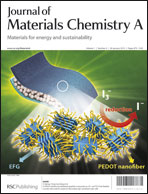This study reports a high-performance hybrid lithium-ion anode material using coaxially coated silicon shells on vertically aligned carbon nanofiber (VACNF) cores. The unique “cup-stacking” graphitic microstructure makes VACNFs a good lithium-ion intercalation medium and, more importantly, a robust bush-like conductive core to effectively connect high-capacity silicon shells for lithium-ion storage. The vertical core–shell nanowires remain well separated from each other even after coating with bulk quantities of silicon (equivalent to 1.5 μm thick solid films). This open structure allows the silicon shells to freely expand/contract in the radial direction during lithium-ion insertion/extraction. A high specific capacity of 3000–3650 mA h (gSi)−1, comparable to the maximum value of amorphous silicon, has been achieved. About 89% of the capacity is retained after 100 charge–discharge cycles at the C/1 rate. After long cycling, the electrode material becomes even more stable, showing the invariant lithium-ion storage capacity as the charge–discharge rate is increased by 20 times from C/10 to C/0.5 (or 2C). The ability to obtain high capacity at significantly improved power rates while maintaining the extraordinary cycle stability demonstrates that this novel structure could be a promising anode material for high-performance lithium-ion batteries.

You have access to this article
 Please wait while we load your content...
Something went wrong. Try again?
Please wait while we load your content...
Something went wrong. Try again?


 Please wait while we load your content...
Please wait while we load your content...